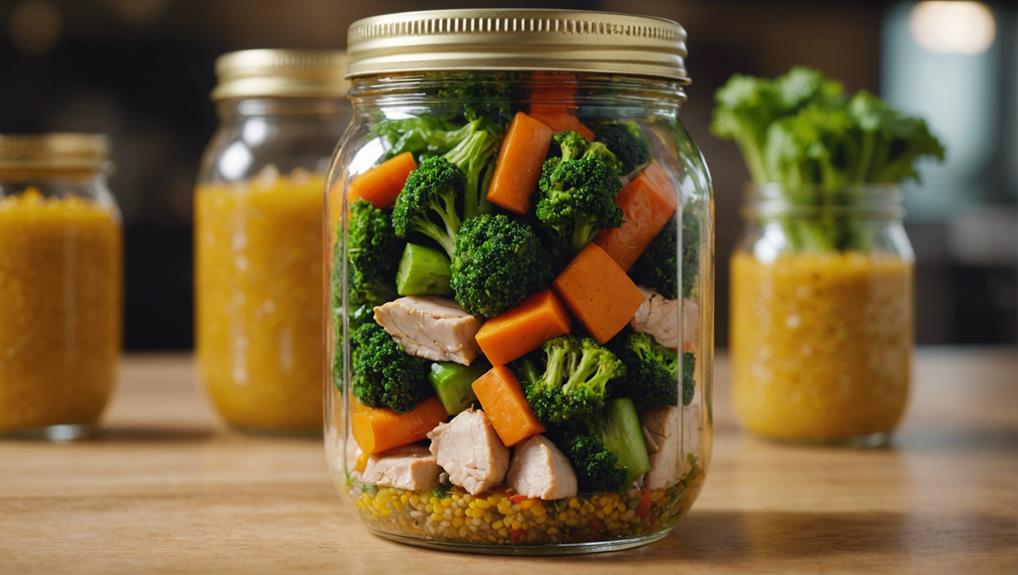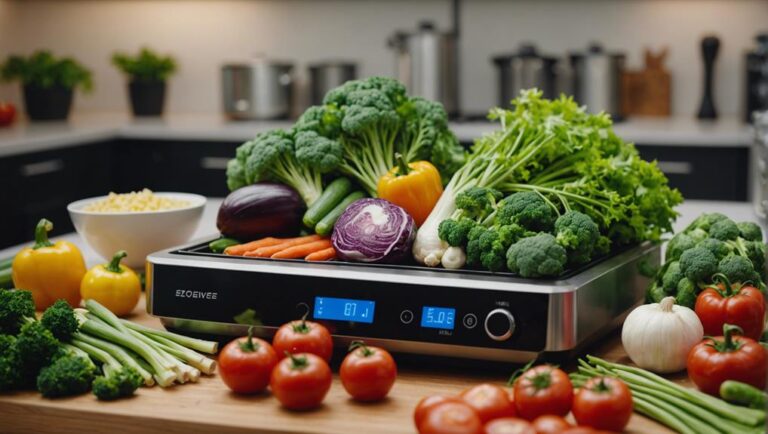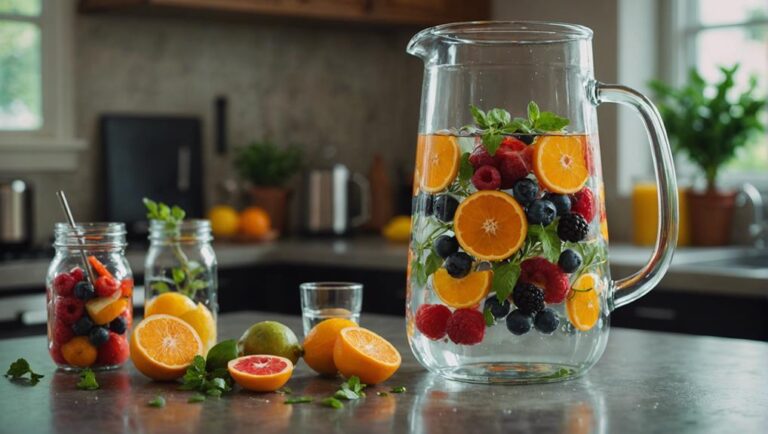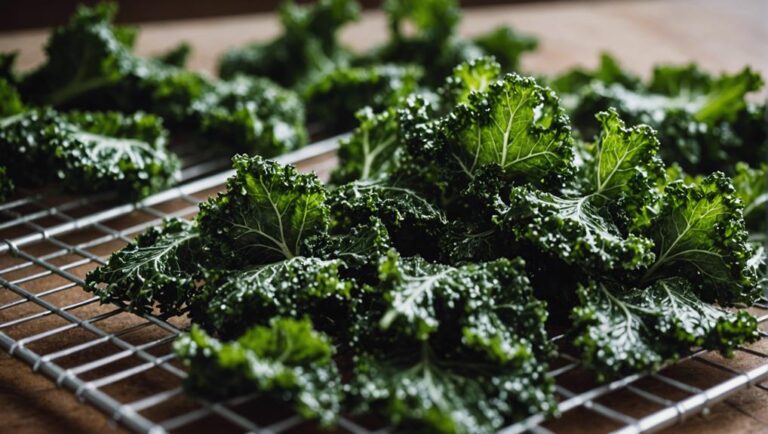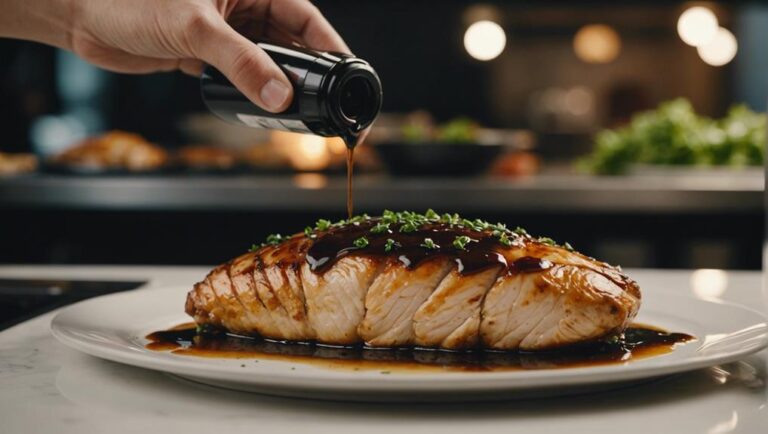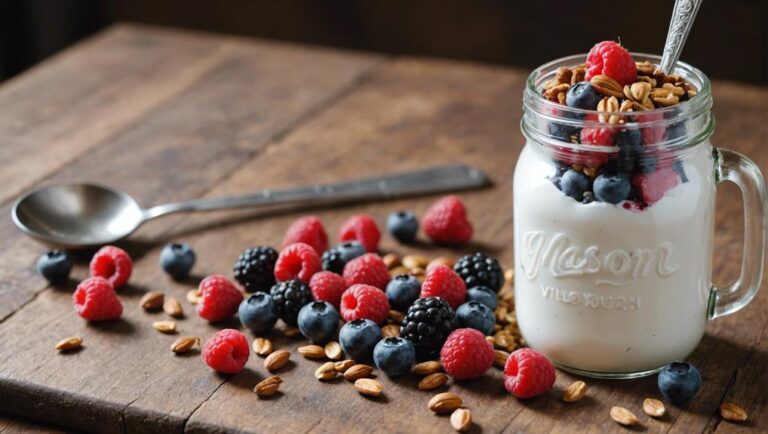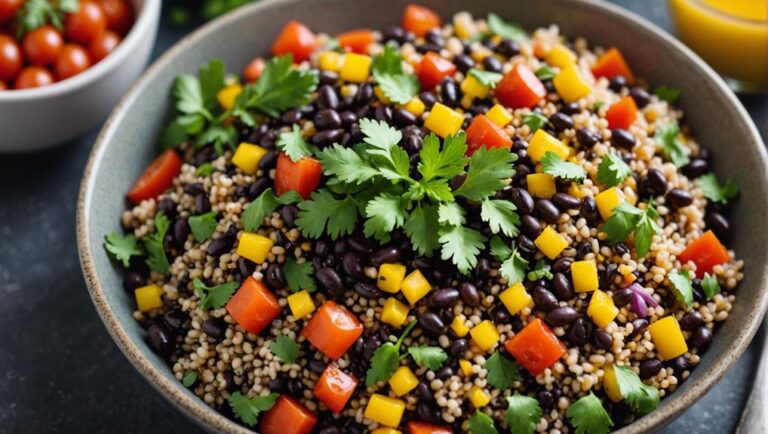Sous Vide Chicken Vegetable Soup
Indulge in a culinary masterpiece with tender sous vide chicken, vibrant vegetables, and flavorful broth in a comforting soup. The sous vide method guarantees chicken peak juiciness and veggies' perfect textures for a wholesome meal. Perfect temperatures are crucial for tenderness, flavor retention, and nutrient preservation. Precise control guarantees a consistent cook every time. Get ready to savor every spoonful of this nourishing soup that perfectly balances flavors and nutrients. Learn more about the temperature guide to achieve impeccable results.
What You Will Learn Here
- Sous vide cooking ensures tender chicken and perfectly cooked vegetables.
- Precise temperature control enhances flavors and retains nutrients in the soup.
- Chicken reaches peak juiciness between 140-165°F (60-74°C) in sous vide.
- Following recommended sous vide cooking times guarantees food safety.
- Chef Chris Holland's innovative sous vide techniques elevate traditional soup recipes.
Soup's Evolution Over Time

Over the centuries, chicken vegetable soup has undergone a remarkable transformation, blending historical roots with modern variations.
The soup's evolution reflects a culinary journey that has embraced diverse ingredients and cooking techniques to enhance both taste and health benefits.
As recipes continue to evolve, the nutritional value and comforting nature of chicken vegetable soup remain timeless.
Historical Roots of Soup
The evolution of soup through history showcases its transformation from a simple nourishing dish to a culinary art form embraced by cultures worldwide. Chicken, water, and various ingredients have been the building blocks of soups since ancient times, with evidence of soup-like dishes dating back to around 20,000 BC.
The word 'soup,' originating from the French word 'soupe,' has traversed through different cultures and cuisines, adapting and evolving along the way. In the Middle Ages, soup served as a practical way to stretch ingredients and create a hearty meal for both the affluent and the less privileged.
The Industrial Revolution revolutionized soup production, leading to the mass availability of canned soups, making them more convenient for consumers. Today, soups continue to be enjoyed globally in diverse variations that reflect regional ingredients, flavors, and culinary traditions.
Modern Soup Variations
Experiencing a culinary revolution, modern soup variations have transcended traditional boundaries, embracing a fusion of global flavors and innovative techniques to redefine the art of soup-making. Chefs now push the limits by incorporating flavorful chicken stock into dishes like Sous Vide Chicken Soup, elevating the richness and depth of flavors. The evolution of soups has seen a shift towards creative ingredients such as exotic spices, unique vegetables, and inventive garnishes, adding layers of complexity to every spoonful. Contemporary soups no longer confine themselves to one cultural influence but instead draw inspiration from around the world, infusing Asian, Mediterranean, or Latin American elements into their recipes. Texture contrasts have become a hallmark of modern soups, with chefs experimenting with sous vide, foams, gels, and dehydrated components to create unforgettable dining experiences.
| Modern Soup Variations | Evolutionary Aspects |
|---|---|
| Global Flavor Fusion | Asian, Mediterranean, Latin American influences |
| Innovative Techniques | Sous vide, foams, gels, dehydrated components |
| Creative Ingredients | Exotic spices, unique vegetables, inventive garnishes |
Nutritional Benefits of Soup
Evolutionary changes in soup recipes over time haven't only enhanced their nutritional value but also expanded the culinary possibilities for creating healthy and flavorful meals.
From simple broths to nutrient-packed concoctions, soups have undergone a transformation that caters to diverse dietary needs. Incorporating ingredients like chicken breast provides a lean protein source, while vegetables offer an array of vitamins and minerals.
The method of cooking, such as using a water bath in sous vide preparation, guarantees that nutrients are retained without compromising flavor.
This evolution in soup-making reflects a shift towards more health-conscious and balanced eating habits. By embracing the nutritional benefits of soup, individuals can enjoy a nourishing meal that supports overall well-being.
Key Soup Components

When crafting a rich and wholesome Sous Vide Chicken Vegetable Soup, the foundation lies in carefully selecting and combining an array of fresh ingredients and aromatic seasonings. Here are key components that contribute to the depth of flavor and nutritional value of this comforting dish:
- Chicken: The star of the show, tender sous vide-cooked chicken adds protein and a hearty base to the soup.
- Vegetables: A colorful medley of vegetables such as carrots, celery, and onions not only enhance the taste but also provide essential vitamins and minerals.
- Herbs and Seasonings: Flavorful herbs like thyme, rosemary, and bay leaves, along with seasoning blends, elevate the taste profile, adding layers of complexity to the soup.
- Broth: A well-crafted broth, whether homemade or store-bought, ties all the ingredients together, infusing the soup with deep, savory flavors.
These components work harmoniously to create a nourishing and satisfying soup that can be easily customized to suit your taste preferences and dietary requirements.
Tasty Chicken Noodle Recipe
If you're craving a comforting and classic dish, the tasty chicken noodle recipe is a go-to option.
Savory Chicken Noodle Variation, Chicken Tortilla Soup Variant, and Chicken and Rice Soup are delicious alternatives worth exploring. Each variation offers a unique blend of flavors and textures, making them perfect choices for a heartwarming meal.
Savory Chicken Noodle Variation
For a comforting and satisfying meal, indulge in this rich and flavorful Savory Chicken Noodle Soup variation that combines tender chicken, hearty vegetables, and savory egg noodles.
- The tender chicken adds a protein-packed element to the soup, making it a hearty and filling dish.
- The egg noodles provide a comforting and classic touch to the recipe, perfect for cozy nights in.
- The flavorful vegetables not only enhance the nutritional value but also add depth and texture to each spoonful.
- The combination of herbs, lemon juice, and spices elevates the overall taste profile, giving the soup a delicious and aromatic flavor.
Warm up on a cold day with this nutrient-packed and delicious soup that's sure to become a favorite at your dinner table.
Chicken Tortilla Soup Variant
Indulge in a tantalizing twist on the classic chicken noodle soup with this flavorful Chicken Tortilla Soup Variant that promises a delicious fusion of textures and spices.
- Vacuum Seal: To intensify the flavors, vacuum seal the marinated chicken with a blend of Mexican spices before sous vide cooking.
- High Heat: After the sous vide process, sear the chicken on high heat for a crispy exterior while keeping the meat tender and juicy.
- Crunchy Tortilla Strips: Top your soup with crunchy tortilla strips for a satisfying contrast in texture.
- Fresh Avocado: Add slices of creamy avocado just before serving to bring a cooling element to the warm, spicy broth.
This variant offers a delightful play on traditional flavors with a modern cooking technique, elevating your chicken noodle soup experience.
Chicken and Rice Soup
Elevate your soup game with a comforting and satisfying Chicken and Rice Soup that blends tender chicken, aromatic rice, and hearty vegetables in a flavorful broth. Here are four reasons why this classic dish deserves a spot in your recipe rotation:
- Ease and Comfort: Chicken and Rice Soup is a go-to comfort food that's both easy to make and incredibly satisfying.
- Versatility: Customize your soup with different herbs, spices, and vegetables to tailor it to your taste preferences.
- Nourishing and Warming: Perfect for cold weather days, this soup provides a nourishing and warming meal option.
- Adaptability: Adjust the recipe to accommodate dietary restrictions or preferences without compromising on flavor or heartiness.
Embrace the simplicity and warmth of this timeless chicken soup recipe.
Sous Vide Temperature Guide
When it comes to sous vide cooking, the Sous Vide Temperature Guide is your go-to tool for precision.
It outlines ideal cooking temperatures, cooking times, and food safety guidelines for various ingredients.
Following this guide guarantees consistent results and helps you master the art of sous vide cooking.
Optimal Cooking Temperatures
To achieve peak results when cooking chicken and vegetables using sous vide, precise temperature control is essential for ensuring tenderness, flavor retention, and nutrient preservation. Chicken cooked sous vide typically achieves peak juiciness and tenderness between 140-165°F (60-74°C).
Vegetables like zucchini and red bell peppers require specific temperatures, such as 183°F (84°C), to maintain their textures and flavors. Sous vide precision cookers allow for consistent cooking by maintaining exact temperatures throughout the process.
Following a sous vide temperature guide guarantees that proteins and vegetables reach the desired doneness without compromising taste or nutrients. Cooking at precise temperatures in sous vide not only enhances flavors but also helps retain the essential nutrients and textures of ingredients like chicken and vegetables.
Sous Vide Cooking Times
Exploring the Sous Vide Cooking Times through the Temperature Guide provides a roadmap to perfectly cooked proteins and vegetables with precision and consistency. When cooking chicken sous vide, it is crucial to guarantee the meat reaches a safe temperature to eliminate any harmful bacteria. Here's a helpful table to guide you through the recommended sous vide cooking times and temperatures for chicken:
| Level of Doneness | Temperature (F) | Time (hours) |
|---|---|---|
| Rare | 140 | 1.5 |
| Medium | 150 | 1.5 |
| Well Done | 165 | 1.5 |
Food Safety Guidelines
For precise food safety in sous vide cooking, adherence to recommended temperature guidelines is essential. When cooking chicken sous vide, it's vital to guarantee that the internal temperature reaches at least 165°F (73.9°C) to eliminate any harmful bacteria and ensure safe consumption.
Before sealing the chicken in a vacuum bag, make sure it's cooked thoroughly at the specified temperature and duration. Sous vide cooking provides a controlled environment that allows you to maintain the desired temperature consistently, ensuring food safety.
Final Thoughts
In reflecting on Chef Chris Holland's journey and contributions to the culinary world, it becomes evident that his dedication to education and technological advancement is shaping the future of the UK food scene. His innovative approach to sous vide cooking, as seen in the flavorful Chicken Noodle soup recipe with a hint of bay leaf, showcases his commitment to enhancing traditional dishes with modern techniques. Chef Holland's accolades, including awards like Cheshire Restaurant of the Year and Chef of the Year, underscore his culinary prowess and influence in the industry.
Through his shift to culinary education, Chef Holland hasn't only shared his knowledge but also inspired a new generation of chefs to embrace innovation and creativity in their cooking. His emphasis on integrating technology into culinary practices highlights his forward-thinking mindset and commitment to pushing boundaries.
As Chef Chris Holland continues to explore new flavors and techniques, his passion for food and dedication to education serve as a driving force in shaping the evolving landscape of the UK food scene.
Frequently Asked Questions
Can You Sous Vide Chicken and Vegetables Together?
Yes, you can sous vide chicken and vegetables together. Ensuring uniform cuts and vacuum sealing both ingredients in one bag allows for precise cooking control and flavor infusion. Retaining individual tastes while cooking at the same temperature.
Can You Use Sous Vide for Soup?
Yes, you can use sous vide for soup. It's a method that locks in flavors, cooks ingredients evenly, and retains nutrients. It guarantees a consistent and delicious outcome every time. Plus, it's convenient for preparing ahead and reheating without quality loss.
Why Is My Sous Vide Chicken Rubbery?
When your sous vide chicken turns rubbery, it's likely due to overcooking at high temperatures. To maintain tenderness, cook at lower temperatures for longer periods. Properly sealing the chicken with seasonings and using a precise sous vide machine are essential.
What Is the Best Temperature to Sous Vide Chicken?
For the best results when sous vide cooking chicken, aim for temperatures between 140-165°F. Lower temps like 140°F give tender, juicy meat, while 160-165°F guarantee food safety. Experimenting with temps can lead to various textures and flavors.
Conclusion
To sum up, sous vide chicken vegetable soup offers a modern twist on a classic comfort food.
The precise temperature control of sous vide cooking guarantees that the chicken is perfectly tender and the vegetables are cooked to perfection.
This method allows for a depth of flavor that traditional cooking methods may not achieve.
With its delicious taste and easy preparation, sous vide chicken vegetable soup is sure to become a new favorite in your kitchen.
